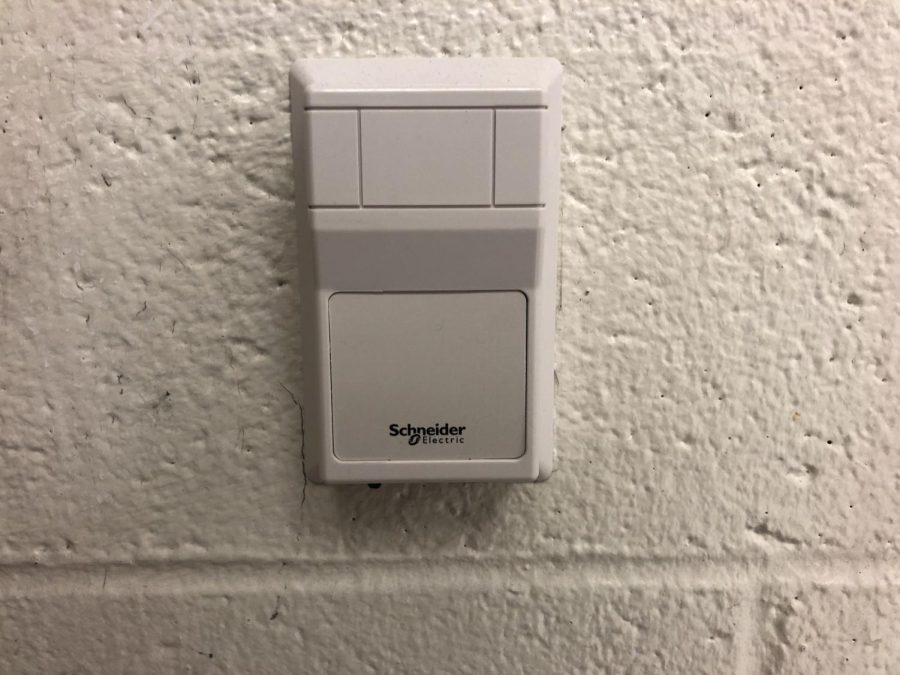Too hot, too cold: WCHS’ never-ending Goldilocks problem
These recently-installed thermostat sensors allow WCHS teachers to warm or cool their classroom by two degrees.
March 21, 2023
Even though it is nearing the dead of winter—with excitement in the air over snow flurries and holiday break—WCHS junior Ana Grazziani finds the heat unbearable.
On the flip side, WCHS history teacher Erin Brown is putting on her winter coat as she returns from her lunch break. She knows that her classroom is usually cold, but today, it feels unusually frigid.
At WCHS, being forced to traverse extreme temperatures as students and staff travel from room to room is a daily reality.
“[The temperatures] are definitely a big issue. In the morning, I’ll be freezing in math class, and by the end of the day, I’ll be sweating in physics,” Grazziani said.
A major source of frustration for many teachers is their limited ability to choose the temperature range of their classroom. However, recent upgrades in WCHS facilities have given them more control over the heating, venting and air conditioning (HVAC) system in their rooms.
“We used to have a temperature box that had a screw on and you couldn’t access it at all. However, one of the newer upgrades to my classroom is this thermostat [near the door],” Brown said. “With this updated system, there’s a cooler and warmer side that I can switch between. There’s no thermometer that I can see, so I don’t know how much of a difference it really makes, but at least I have a way to make it better when my room gets really hot or really cold.”
Although this seems like a small change, it is a victory for WCHS administrators like Lisa Wellek, who have been putting pressure on MCPS officials to prioritize HVAC renovations for years.
“The HVAC system at WCHS is complex. There are several air handlers and individual room units, which make diagnosing issues difficult,” Wellek said. “We have been continually talking to MCPS Divisions of Maintenance, and that has enabled us to get valves replaced and sensors installed. Although the ‘set point’ of school temperatures is programmed by the Building Automated Systems team, these new sensors allow staff to select a setting that warms or cools a room by two degrees.”
Since the MCPS ‘set point’ is 68-76 degrees, this range accounts for the seemingly random fluctuations between WCHS classrooms. The variability is further compounded by factors such as open windows, number of occupants, proximity to heat sources and external temperature.
“There’s this misconception that the school HVAC system operates like a home system, where if something is broken, we can call somebody, it’s fixed, and we’re back and running the next day,” Wellek said. “Since WCHS is a single-mode system, we’re either in heating or air conditioning mode, and cannot toggle between the two. The majority of our issues occur when the change of season contradicts with the HVAC mode.”
A 2014 study conducted by the Regional Educational Laboratory Program found that there is a direct correlation between extreme temperatures and student performance. Most noticeably, high school students scored an average of 72 percent versus 90 percent on assessments when the classroom temperature was set at 81°F versus 72°F, respectively.
“I know that [students] have to go between seven different classrooms every day, and they all have different comfort levels, so I can only imagine what it’s like for them,” Brown said. “When the room is hot, a student can become sleepy and it is hard to focus. When it is cold, you’re just uncomfortable. I have no doubt that it’s disruptive to the learning process.”
Likewise, oscillating classroom conditions also limit the abilities of teachers, forcing them to work twice as hard to teach in engaging ways.
“I’ve taught here and it’s been so cold that I had to wear my coat,” Brown said. “I’ve wanted to put my hood on. My hands have felt like ice. And because it’s my job as a teacher to be a model for my students, I try to carry on as best I can, but it’s brutal at times.”
A frequent concern that students have is the lack of tangible progress that MCPS has been making regarding HVAC-related problems.
“There’s an obvious discrepancy between the amount that people are paying for taxes and the facilities of these schools. So, where is this money going?” Grazziani said. “I think that MCPS tends to make performative decisions instead of focusing on actual issues that impact students. They need to adjust their priorities, because there are clear problems that they are not addressing.”
For the most part, though, building upgrades such as the sensor thermostat and valve replacements point towards a promising future.
“I find it frustrating that I’ve seen so little change over the years I’ve been working [at WCHS], but I’ve seen a concentrated effort this year of reporting issues and really trying to make it better, through online forms and targeted fixes by building service teams,” Brown said. “I still think there’s a long way to go, but there is a responsiveness and a focus that is newer and prolonged, which makes me glad and hopeful for more progress going forward.”



